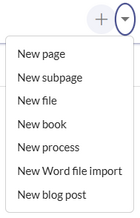An important aspect of the wiki principle is that content can be created, edited and shared quickly with others. Changes to wiki pages can be tracked and reversed at any time via the version history. Therefore, a wiki should limit editing rights sparingly to allow for the greatest possible collaboration.
Creating a page
To create a page:
- Click the + button in the Header. A dialog window opens.
- Enter a page name. If the page already exists, it will be listed under the text field. This makes it easier to create the new page as a subpage. If you want to create the page in an existing namespace, add the namespace name as a prefix, followed by a colon. Example:
Manual:Visual editing
Create a new page - Click done.
- Choose Blank Page or a page template if your wiki shows the page templates page as the next step. This step is omitted if no page templates are available. The page now opens in edit mode.
- Save the page. After saving the page for the first time, the page exists in the wiki. Click the edit icon of the page to switch back to edit mode.
Changing the page name
If you want to change the page name later (e.g., to store it in another namespace), you need to move the page.
Adding subpages
To create a subpage for the current page, select the New subpage link from the New menu.

The subpage is then created as page current page/subpage, e.g. VisualEditor/Tables. If a page has subpages, the path is displayed via the breadcrumb navigation at the top of the page. The character / is only used to create a subpage. This means that you cannot create a wiki page called When/how to take a vacation as this will result in a main page When with its subpage how to take a vacation.
Page name conventions
- Title choice: In a wiki, titles are very important. In wikis with many entries, it happens that authors set links to pages that they consider important in the context of their entry. Single words work well, but short phrases like "why wikis work" can also be goood page names. In addition, meaningful page titles also make it easier for readers to find their way around and to search for an article using the title search.
- Namespaces: To create an article in another namespace, its name must be preceded by the namespace prefix, i.e.
namespace:articlename. An article name can exist multiple times in the wiki as long as it is in different namespaces. - Special characters: The following characters cannot be used in titles:
{ } & ? < > \and,. You can find more about this at Mediawiki. - Spelling: When linking to an already existing page in source edit mode, you should pay attention to the exact spelling. For example, if you enter
[[Hello world]]instead of[[Hello World]], links to two different pages are created, because the page names are case sensitive. Only the first letter of a (parent) page is case-insensitive. Subpage names are completely case-sensitive.
Alternative options for page creation
There are other handy ways to create a page in the wiki:
- Redlink: If you are currently editing a wiki page, you can directly select a text passage and set a link to a non-existent page. This creates a red-formatted link (redlink) for which there is no wiki page yet. The non existing page is then also listed on the special page
Wanted files. - Browser address bar: You can also create a page directly from the address bar of your web browser. To do this, simply replace the title of the current page with a new page name. If you then press Enter, the new page will open.
- Inputbox: Input field that can easily be added to any page that includes predefined parameters to ensure the page is created in a particular namespace or using a particular page template.
- Form: In BlueSpice pro, there is also the possibility to create pages using forms. This has the advantage that you can pass different page parameters, such as a page template or various template parameter values to a new page during page creation.